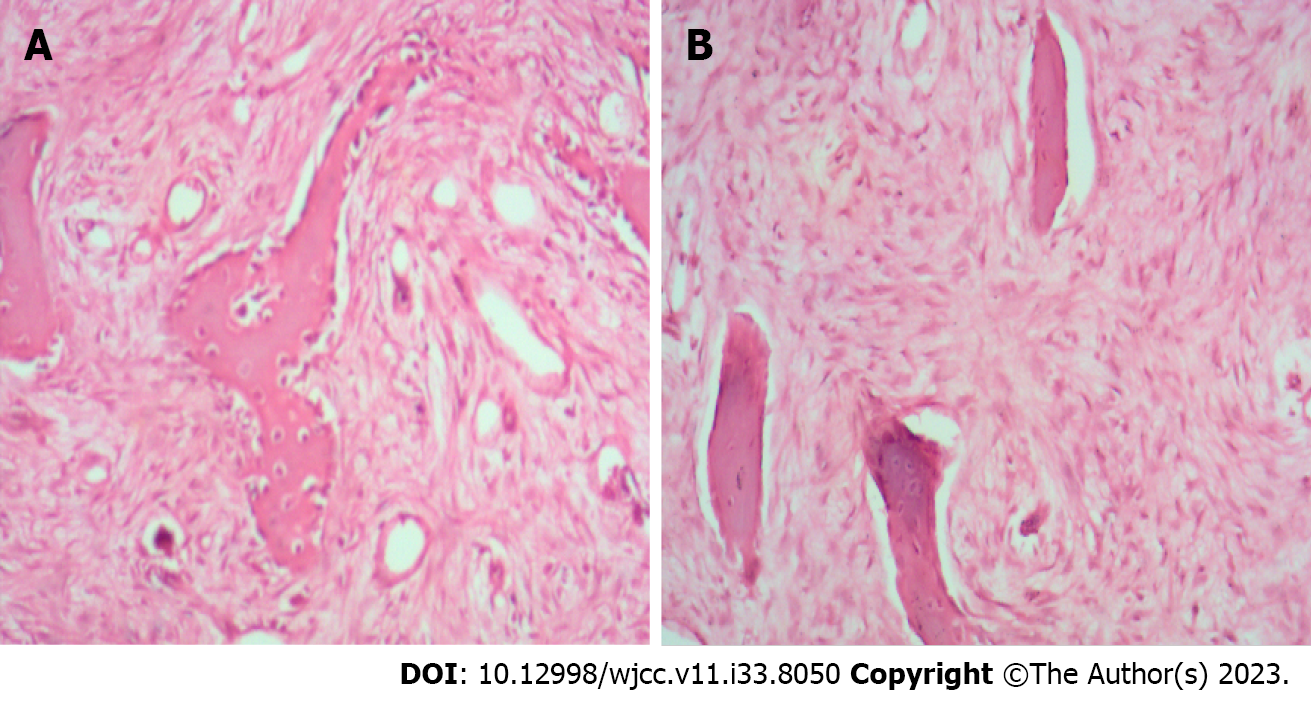Copyright
©The Author(s) 2023.
World J Clin Cases. Nov 26, 2023; 11(33): 8050-8057
Published online Nov 26, 2023. doi: 10.12998/wjcc.v11.i33.8050
Published online Nov 26, 2023. doi: 10.12998/wjcc.v11.i33.8050
Figure 1 Preoperative radiographic images of fibular fibrous dysplasia.
A: Preoperative anteroposterior and lateral X-ray showed ground-glass appearance and partial radiolucent lesions with clear borders around soft tissue (arrows); B: Preoperative computed tomography showed erosion-like changes and cystic appearance without extraosseous soft tissue mass destruction (asterisks); C: Preoperative magnetic resonance imaging (MRI). T1-weighted, T2-weighted, and fat-suppressed MRI of the left fibular bone showed low to intermediate signals on T1 and T2-weighted images and high signals on fat-suppressed image (arrows).
Figure 2 First results of intraoperative and postoperative pathological examination.
A and B: Hematoxylin and eosin staining (magnification 40 ×). Intraoperative rapid pathological examination showed typical appearance of fibrous dysplasia. The lesion contained some irregular immature bone trabeculae scattered within fibrous tissue; C and D: Postoperative regular pathological examination showed the same appearance of irregular trabecular bone and hyperplastic fibrous tissue with woven bone formation.
Figure 3 First postoperative X-ray images of fibular fibrous dysplasia.
A and B: Postoperative anteroposterior and lateral X-ray showed a radiographically apparent allogeneic bone refilling of ground-glass and partial radiolucent sites in X-ray images compared to preoperative X-ray images as showed in Figure 1A.
Figure 4 Preoperative radiographic images of recurrent fibular fibrous dysplasia.
A: Preoperative computed tomography showed expanded lesions with a shell (asterisks), and small perforations with erosion-like changes (arrows); B: Preoperative anteroposterior and lateral X-ray also showed ground-glass appearance (asterisks) and sclerotic borders and expanded lesions with well-circumscribed margins (arrows); C: Preoperative magnetic resonance imaging (MRI). T1-weighted, T2-weighted, and fat-suppressed MRI of the left fibular bone showed low to intermediate signals on T1 and T2-weighted images and high signals on fat-suppressed image, and well-circumscribed margins without extraosseous soft tissue mass destruction were observed (arrows).
Figure 5 Postoperative pathological examination of recurrent fibular fibrous dysplasia.
A and B: Hematoxylin and eosin staining (magnification 40 ×). Areas of fibrous dysplasia and curvilinear trabeculae of metaplastic woven bone in hypocellular fibroblastic stroma were observed.
Figure 6 Postoperative radiographic images of recurrent fibular fibrous dysplasia.
A: Preoperative anteroposterior showed that longus fibula allograft transplantation combined with fibular bone locking plate and screws was performed for reconstruction. Clear boundaries are shown by X-ray at the proximal fibular lesion (arrow); B: Bony callus of autogenous fibular bone and allogenic fibular bone were found by X-ray of the proximal fibular lesion at 6 mo postoperatively (arrow); C: Fusion of strong autogenous fibular bone with allogenic fibular bone was found by X-ray after 1 year postoperatively (arrow); D: Fibular locking plate and screws were removed surgically after 1 year, and X-ray showed ideal bone fusion of proximal and distal fibular lesions (arrows).
- Citation: Xie LL, Yuan X, Zhu HX, Fu L, Pu D. Fibula allograft transplantation combined with locking plate for treatment of recurrent monostotic fibular fibrous dysplasia: A case report. World J Clin Cases 2023; 11(33): 8050-8057
- URL: https://www.wjgnet.com/2307-8960/full/v11/i33/8050.htm
- DOI: https://dx.doi.org/10.12998/wjcc.v11.i33.8050


















